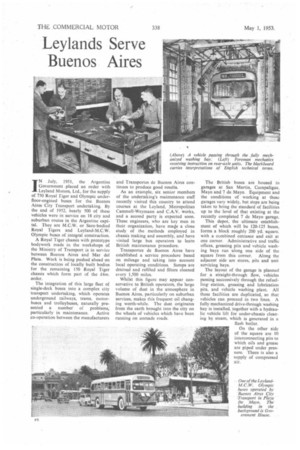Leylands Serve Buenos Aires
Page 96

If you've noticed an error in this article please click here to report it so we can fix it.
IN July, 1951, the Argentine Government .placed an order with Leyland Motors, Ltd., for the supply of 750 Royal Tiger and Olympic underfloor-engined buses for the Buenos Aires City Transport undertaking, By the end of 1952, nearly 500 of these vehicles were in service on 18 city and suburban routes in the Argentine capital. They are M.C.W. or Saro-bodied Royal Tigers and Leyland-M.C.W. Olympic buses of integral construction.
A Royal Tiger chassis with prototype bodywork made in the workshops of the Ministry of Transport is in service between Buenos Aires and Mar del Plata. Work is being pushed ahead on the construction of locally built bodies for the remaining 150 Royal Tiger chassis which form part of the £4m. order.
The integration of this large fleet of single-deck buses into a complex city transport undertaking, which operates underground railways, trams, motorbuses and trolleybuses, naturally presented a number of problems; particularly in maintenance. Active co-operation between the manufacturers and Transportes de Buenos Aires continues to produce good results.
As an example, six senior members of the undertaking's maintenance staff recently visited this country to attend courses at the Leyland, Metropolitan Cammell-Weymann and C.A.V. works, and a second party is expected soon. These engineers, who are key men in their organization, have maile a close study of the methods employed in chassis making and assembly, and have visited large bus operators to learn British maintenance procedure.
Transportes de Buenos Aires have established a service procedure based on mileage and taking into account local operating conditions. Sumps are drained and refilled and filters cleaned every 1,500 miles.
Whilst this figure may appear conservative to British operators, the large volume of dust in the atmosphere in Buenos Aires, particularly on suburban services, makes this frequent oil changing worth-while. The dust originates from the earth brought into the city on the wheels of vehicles which have been running on unmade roads. The British buses are housed in garages at San Martin, Curapaligue, Mayo and 7 de Mayo. Equipment and the conditions of working at these garages vary widely, hut steps are being taken to bring the standard of facilities up to the level of that existing at the recently completed 7 de Mayo garage.
This depot, the ultimate establishment of which will be 120-125 buses, forms a block roughly 200 yd. square. with a combined entrance and exit at one corner. Administrative and traffic offices, greasing pits and vehicle washing bays run 'along one side of the square from this corner. Along the adjacent side are stores, pits and unit servicing bays.
The layout of the garage is planned for a straight-through flow, vehicles passing successively through the refuelling' station, greasing and lubrication pits, and vehicle washing plant. All these facilities are duplicated, so that vehicles can proceed in two lines, A fully mechanized drive-through washing bay is installed, together with a hydraulic vehicle lift for under-chassis cleaning by steam, which is generated in a flash boiler.
On the other side of the square are 10 interconnecting pits to which oils and grease are piped under pressure, There is also a supply of compressed air.








































































































































































































































